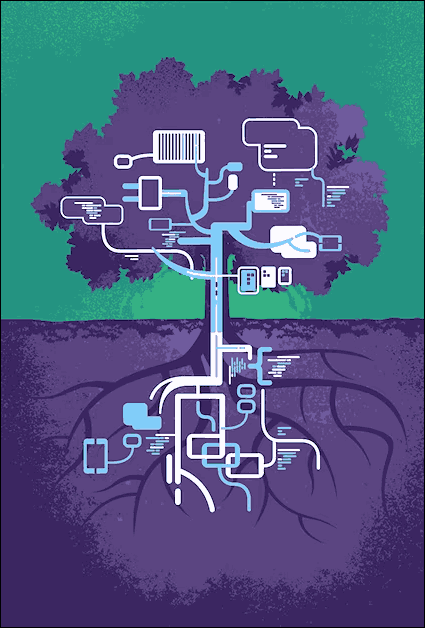
Merkle Tree: Powering Blockchain Integrity & Efficiency
Dive into the world of Merkle Trees and discover their crucial role in enhancing data verification and efficiency in blockchain technology....

Dive into the world of Merkle Trees and discover their crucial role in enhancing data verification and efficiency in blockchain technology....
The Merkle tree is a critical component in blockchain architecture. It is deeply integrated into the foundations of security, efficiency, and trust within decentralized networks. Simply put, it acts as a strong mechanism to guarantee the reliability of data.
This article discusses the importance of Merkle trees in blockchains, and explores how Markle trees work. Additionally, it also discusses the benefits of merkle tree in blockchain and how it fosters transparency, trust, and efficiency within decentralized systems.
Let’s start off by understanding – what is a Merkle tree? and how do Merkle trees work?

Source| Merkle tree in blockchain
A Merkle tree, named after its inventor, Ralph Merkle, is a fundamental data structure to organize and secure digital information. It is a tree structure where each leaf node represents a data block, and each non-leaf node is a hash of its child nodes. This hierarchical arrangement creates a unique fingerprint for the entire dataset, ensuring data integrity and facilitating efficient verification.
A Merkle tree is also referred to as a hash tree. It stands as a fundamental data structure in the world of cryptography, blockchains, and web3 space, serving the critical role of ensuring the integrity of data elements within extensive datasets. Its primary objective is upholding data integrity by implementing robust hash functions.
At the top of the Merkle tree stands the Merkle Root, a single hash representing the entire dataset. This is achieved by hashing the combination of the highest-level nodes. Essentially, it’s a straightforward mathematical method used to authenticate the data within a Merkle tree in the blockchain.
The Merkle root is used in crypto to ensure data blocks added to a peer-to-peer network are whole, undamaged, and unaltered. Any alteration to the underlying data would necessitate a change in the Merkle root, making it a crucial element in ensuring the integrity of the blockchain or lack thereof.
Here is how the mechanism of a Merkle tree works:
When a block is added to the blockchain, only the Merkle root needs to be stored, significantly reducing storage requirements. Moreover, this data structure plays a crucial role in ensuring the immutability of the blockchain by making it impossible to alter data related to past transactions.
Now, let’s look at the benefits of Merkle Tree in blockchain:
Here are some use cases of Merkle tree in blockchain:
A Merkle hash tree function is a cryptographic process that transforms any type of arbitrary data, regardless of its length, into a fixed-size output.
Merkle hash tree is renowned for its effectiveness in cryptography. The Merkle hashing function possesses a distinctive characteristic—irreversibility. It is a one-way cryptographic method designed to operate in a singular direction. Notable hash families such as SHA-2 and SHA-3.

Source: Freepik | Importance of Merkle tree in blockchain
Merkle tree in blockchain is useful in the following ways:
In conclusion, the Merkle tree is a foundational element underpinning blockchain technology’s integrity and security. Its hierarchical structure, cryptographic hashing, and the ability to condense data into a single, verifiable root are essential for maintaining the immutability and efficiency of distributed ledgers.
As blockchain continues to evolve and find applications across diverse industries, the Merkle tree stands as a testament to the innovation and robustness required to secure and streamline digital transactions.
The Merkle root holds paramount significance in blockchain by serving as a condensed representation of the entire dataset. It ensures data integrity, making any tampering detectable. The Merkle root is crucial for validating the authenticity of information stored in blocks, enhancing the security and trustworthiness of blockchain systems.
The components of a Merkle tree include leaf nodes, representing individual data blocks, non-leaf nodes, representing hashed pairs of child nodes, and the Merkle root, a single hash summarizing the entire dataset.
What is Typescript | What is Truffle in Blockchain | What is Node JS | What is Foundry | THNDR Games | What is Solidity | What is Hardhat | Difference Between Github and Gitlab | What is Staking in Crypto | Blockchain Technology Applications | What is Blockchain Security | Best Cryptocurrency Exchange | What is Fiat | How to Start Career in Cryptocurrency | NFT Marketplace List | What is the Sandbox Crypto | What is POAP | What is Intrinsic Value | Difference Between Cryptocurrency and Blockchain | Physical Layer in OSI Model | Advantages and Disadvantages of Decentralization | Ordinals NFTs | What are EVM Compatible Blockchains